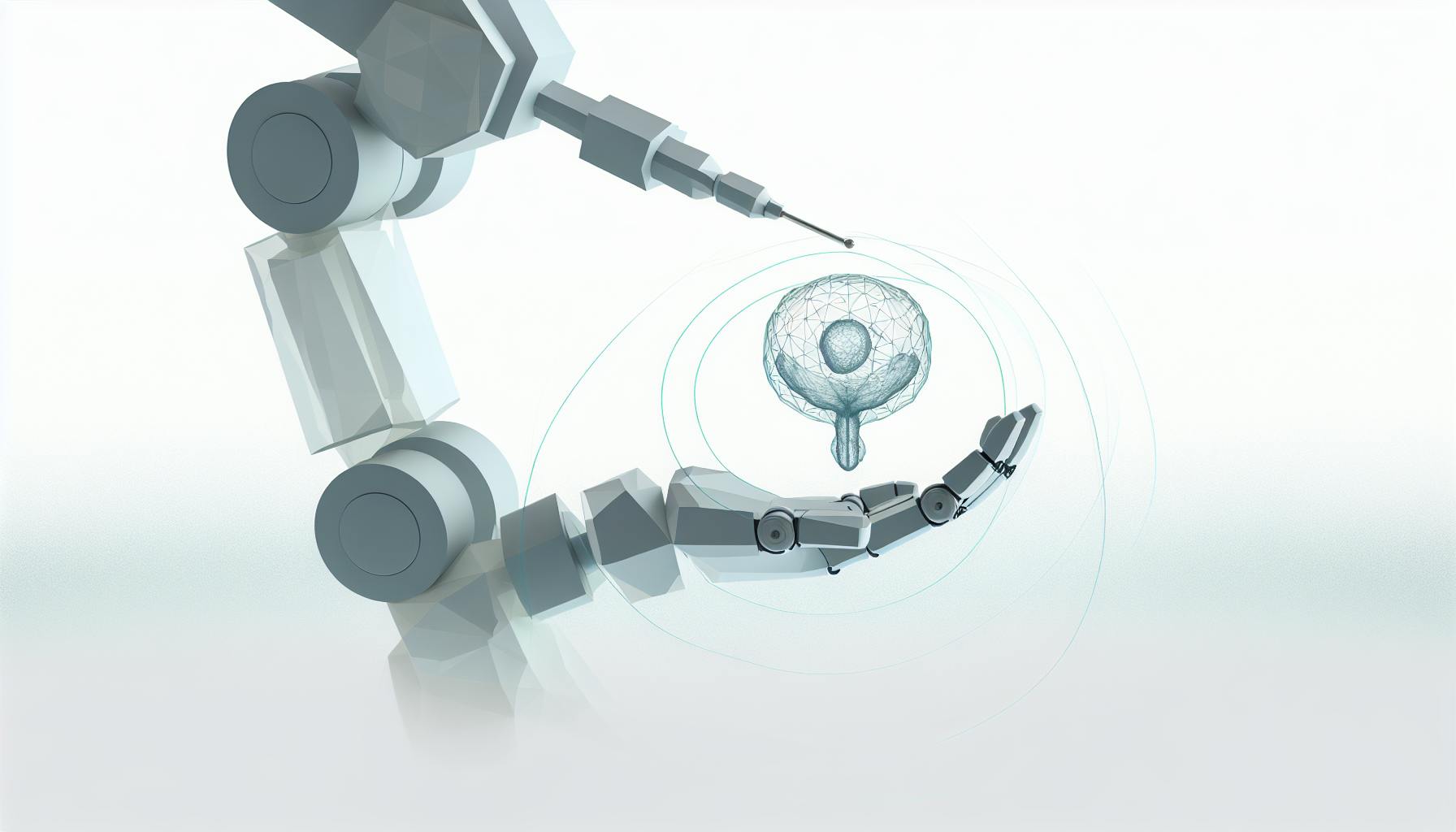Most people would agree that undergoing surgery can be stressful and full of uncertainties.
This article provides a comprehensive overview of robotic surgery, including the conditions it can treat, patient eligibility, and expected outcomes.
You'll learn about the latest robotic technology advancing urologic care, criteria for determining if you're a candidate, milestones for recovery, and more.
Introduction to Robotic Surgery: Revolutionizing Urologic Surgical Care
Robotic surgery has transformed the landscape of urologic surgery over the past two decades. With unparalleled visualization, dexterity, and precision, robotic surgical systems have enabled surgeons to perform complex urologic procedures through tiny incisions with improved outcomes. This introductory section will provide an overview of the evolution, benefits, and limitations of robotic surgery specifically for urologic conditions.
Evolution of Robotic Surgery in Clinical Practice
The concept of robotic surgery first emerged in the 1980s, but widespread adoption for urologic procedures began in the early 2000s after FDA approval of the da Vinci Surgical System. This pioneering robotic platform overcame many limitations of open and laparoscopic surgery with wristed instruments, 3D visualization, and intuitive controls.
Since 2000, robotic surgery has been increasingly utilized for prostate cancer treatment. By 2010, over 80% of radical prostatectomies were performed robotically. Robotic surgery is now standard of care for prostate cancer at most major institutions. Studies demonstrate reduced blood loss, fewer complications, improved cancer control, and faster recovery with robotic prostatectomy.
Robotic surgery has also been adopted for partial nephrectomy, pyeloplasty, nephroureterectomy, and adrenalectomy over the past decade. Robotic approaches reduce morbidity and enable nephron-sparing surgery for small renal masses. Today, robotic surgery can be considered for most urologic operations. Ongoing research aims to expand applications through new platforms, instrumentation, and techniques.
Comparing Methods of Surgery: Robotic vs Traditional Approaches
Compared to open surgery, studies show robotic surgery results in:
- Smaller incisions
- Less blood loss and need for transfusion
- Shorter hospital stay
- Faster return of bladder control and sexual function
- Reduced risk of complications
Robotic surgery also provides superior visualization over laparoscopy with a stable, magnified 3D view inside patient anatomy. Wristed instruments offer a full range of motion through tiny ports. These factors enable greater surgical accuracy and precision.
With experience, robotic prostatectomy can achieve 95% urinary continence rates and 75% erectile function preservation at 2 years. These outcomes match or exceed those of open radical prostatectomy.
Assessing the Limitations and Challenges in Robotic Surgery
Limitations of robotic surgery include high cost and steep learning curves. Lack of haptic feedback can also make tissue manipulation more challenging.
Additionally, robotic surgery may not suitable for all patients depending on body habitus, prior surgeries, and procedure complexity. Open or laparoscopic approaches can be better options in some scenarios.
Ongoing challenges include developing more affordable robotic systems, specialized instruments, and platforms tailored to urologic surgery. Further research and competition in the surgical robotics industry will help address these limitations.
What are surgical conditions?
Surgical conditions refer to medical issues that may require some form of operative intervention to diagnose, treat, or manage the condition. As defined in the context, a surgical condition involves an invasive procedure such as suturing, incision, excision, manipulation, or other techniques that usually necessitate anesthesia - whether local, regional, or general.
Some examples of common surgical conditions that Dr. Canes treats with robotic surgery include:
- Prostate Conditions: Enlarged prostate (BPH), prostate cancer
- Kidney Conditions: Kidney cancer, UPJ obstruction, kidney stones
- Bladder Conditions: Bladder cancer, interstitial cystitis
- Adrenal Conditions: Adrenal masses, pheochromocytoma
- Ureter Conditions: Ureteral strictures, ureteropelvic junction obstruction
The decision of whether a condition requires surgery depends on multiple factors such as the severity of the issue, failure of more conservative treatments, patient preferences, and surgical eligibility based on the patient's medical history and overall health. During the initial consultation, Dr. Canes thoroughly evaluates each unique case to determine if surgical intervention is recommended or required to effectively treat the condition.
What are the top 5 major surgeries?
The top 5 major surgeries performed in the United States include:
Cesarean Section
A cesarean section, also called a C-section, is a surgical procedure used to deliver a baby through incisions in the abdomen and uterus. It is one of the most common surgeries performed on women in the United States. Reasons for needing a C-section include health concerns for the mother or baby, issues with labor progression, prior C-sections, etc. Recovery usually takes 4-6 weeks.
Organ Transplantation
Organ transplantation involves surgically removing an organ from a donor and placing it in the body of the recipient. Common organ transplants include kidney, liver, heart, lung, pancreas and intestine transplants. These life-saving procedures allow patients with organ failure or damage to regain function. Recovery time varies greatly depending on which organ is transplanted.
Joint Replacement
Joint replacement surgery involves removing damaged cartilage and bone from joints like the hip, knee, shoulder or ankle and replacing them with artificial joint components made of metal and plastic. This surgery helps restore joint function and reduce pain in patients with severe arthritis or joint injury. Recovery takes several weeks to months.
Hysterectomy
A hysterectomy is the surgical removal of a woman's uterus. It is performed to treat various uterine and cervical conditions like fibroids, endometriosis, prolapse, cancer, etc. The surgery can be total (removing the whole uterus) or partial. Recovery usually takes about 6 weeks.
Heart Surgery
Heart surgery covers various complex procedures done to treat diseases of the heart and blood vessels. Some common heart surgeries include coronary artery bypass grafting, valve repair/replacement, aneurysm repair, heart transplant, etc. Recovery depends greatly on the type of surgery but generally takes weeks to months.
What conditions need surgery?
Surgery may be recommended for several common urologic conditions, including:
Prostate Conditions
- Prostate cancer - If caught early, prostate cancer can often be treated with robotic radical prostatectomy, which involves surgical removal of the prostate gland. This is considered the gold standard treatment for localized prostate cancer.
- Benign prostatic hyperplasia (BPH) - An enlarged prostate can cause urinary symptoms. Robotic simple prostatectomy is a minimally invasive surgery to remove excess prostate tissue.
Kidney Conditions
- Kidney cancer - Partial or radical nephrectomy (kidney removal) may be needed depending on the type and stage of kidney cancer. Robotic kidney surgery allows precise tumor removal while preserving healthy kidney tissue.
- Kidney stones - For large or difficult to pass kidney stones, surgery may be required to remove them. Robotic pyelolithotomy and robotic ureterolithotomy are advanced, minimally invasive stone removal procedures.
Bladder Conditions
- Bladder cancer - Early stage bladder cancer can be treated with robotic bladder resection surgery to remove the tumor. For more advanced cancer, radical cystectomy with urinary diversion may be necessary.
Adrenal Conditions
- Adrenal masses - Adrenal masses need evaluation to check for cancer risk. Robotic adrenalectomy can remove benign or malignant adrenal gland tumors through small incisions.
In general, robotic surgery results in shorter hospital stays, less pain, lower risk of infection, and faster recovery compared to open surgery. Patients should discuss their specific condition with a urologic oncology specialist to determine if they are eligible for robotic surgery.
sbb-itb-89ec482
What are the 3 main problems in surgery?
While advancements in surgical techniques and technology have made surgery safer, there are still risks involved. Three of the most common issues that can arise during or after surgery include:
Anesthesia Complications
Problems with anesthesia can be rare but serious. Anesthesia allows patients to be unconscious and free of pain during surgery. However, in some cases it can cause:
- Breathing problems
- Changes in blood pressure
- Nausea and vomiting
Careful monitoring by an anesthesiologist during surgery helps reduce these risks.
Infections
Infections after surgery typically occur in less than 5% of patients but can cause:
- Delayed wound healing
- High fevers
- Prolonged pain
Preventative antibiotics and proper wound care helps lower infection risks.
Scarring
Most surgical procedures involve some degree of cutting and suturing of tissue. This causes scarring which for some people can be:
- Painful
- Tight or restrictive
- Cosmetically bothersome
While some scarring is inevitable, techniques like meticulous wound closure and special tape dressings can improve scar appearance.
In summary, anesthesia risks, post-op infections, and scarring are three of the most prevalent issues with surgery. However, risks can be minimized through preventative measures and careful surgical practice. As with any medical procedure, it is important to discuss benefits and potential complications with your healthcare provider.
Navigating the Latest Advancements in Robotic Surgery Technology
This section will focus specifically on the newest developments in robotic surgical systems and techniques uniquely suited to treat urologic conditions. It will highlight specialized instruments, simulation training, remote telesurgery capabilities, and applications like single-port prostatectomy that showcase the technology's ongoing evolution.
Innovative Robotic Instruments Enhancing Urologic Procedures
Robotic surgical systems like the da Vinci allow for the design of miniature instruments uniquely suited for precise manipulation and visualization within the urinary system. This section will describe specialized tools like curved scissors, articulating needle drivers, and cauterizing dissectors that facilitate complex reconstructive procedures.
-
The da Vinci surgical system features EndoWrist instruments with 7 degrees of freedom providing unmatched range of motion for accessing tight spaces and suturing during urologic procedures. These include curved scissors, needle drivers, dissectors, and cautery tools customized for urinary tract reconstruction.
-
Articulating instruments like the da Vinci Vessel Sealer Extend facilitate procedures like partial nephrectomy by reaching tumors in difficult kidney locations while minimizing blood loss through advanced bipolar cauterization.
-
The variety of da Vinci instruments for robotic prostatectomy include curved scissors for precise dissection of tissue planes, ProGrasp forceps for secure handling of organs, and Large Needle Drivers allowing accurate suturing using the smallest needles.
Simulation-Based Training for Robotic Urologic Surgery
Surgeon training for robotic surgery requires extensive simulation-based practice to become proficient in the advanced technology. This section reviews training curriculums for urologic robot-assisted procedures which combine high-fidelity simulated modules focused on tissue handling and anatomy.
-
The da Vinci Skills Simulator provides over 50 exercise modules including needle targeting, peg handling, and suture techniques essential for robotic urologic procedures using real-time metrics and performance analytics.
-
Robotic surgical simulation systems like Mimic allow immersive rehearsal of partial nephrectomies and prostatectomies using accurate tissue response technology and 3D virtual reality to boost surgeon readiness for the OR.
-
Structured robotic training programs at leading institutions combine didactic coursework, online learning modules, and hands-on simulated exercises followed by supervised clinical experience to ensure surgeon mastery of urologic techniques.
Exploring Remote Telesurgery in Urologic Patient Care
An emerging frontier for robotic surgery is telesurgery, which allows an expert surgeon to control the robotic arms from a remote location through a secure internet connection. While still largely experimental, successful demonstrations of long-distance prostatectomy showcase the potential for expanded patient access to top specialists.
-
Recent transcontinental telesurgery has proven the feasibility of remote robotic prostatectomy over thousands of miles without impacting procedure time, demonstrating precise control of surgical arms is possible despite network latency.
-
As robotic telesurgery matures, potential applications include bringing specialized reconstructive techniques for conditions like UPJ obstruction to underserved medical centers lacking on-site subspecialists.
-
Future adoption of remote telesurgery faces regulatory hurdles around device approval and legal concerns about liability, but the technology could greatly expand patient options if governance challenges are addressed.
Determining Patient Eligibility for Robotic Urologic Surgery
This section outlines key factors surgeons consider when evaluating a patient's candidacy for robot-assisted surgery for various urologic conditions. It will provide condition-specific inclusion and exclusion criteria related to parameters like cancer stage, BMI, previous surgeries, and comorbidities.
Criteria for Robotic Prostatectomy: Who is the Right Candidate?
For prostate cancer patients considering robotic prostatectomy, typical eligibility factors include:
- Localized cancer stage (T1-T2)
- Prostate size under 100 grams
- Biopsy Gleason grade under 8
- PSA levels under 10 ng/mL
Comorbidities like uncontrolled heart disease or blood pressure may exclude patients from robotic surgery. However, prior pelvic or prostate surgeries often still allow for robotic techniques. Surgeons evaluate each case individually.
Evaluating Kidney Surgery Candidates for Robotic Intervention
Patients being evaluated for robotic partial nephrectomy for renal masses should meet certain criteria:
- Tumor size under 7 cm
- Tumor located away from the hilum and collecting system
- Limited tumor depth into kidney parenchyma
Other aspects like BMI under 35, well-controlled diabetes, and adequate lung function are also considered.
Understanding Contraindications for Robotic Urologic Surgery
While many patients meet basic eligibility criteria, certain contraindications like:
- Severe COPD or cardiovascular disease
- Recent cardiac stents/bypasses
- Multiple prior surgeries causing extensive abdominal adhesions
may make robotic approaches too high-risk. This section reviews common reasons for exclusion, like prior surgeries or adhesions which impede safe access for robot positioning.
Recovery Outcomes: What Patients Can Expect Post-Robotic Surgery
Robotic surgery offers patients several potential benefits over traditional open surgery or laparoscopy in terms of recovery outcomes. These include reduced blood loss, less post-operative pain, lower risk of complications, and faster return to normal activities.
Analyzing Intraoperative Measures for Robotic Surgery Success
During robotic procedures, surgeons closely monitor key metrics like:
- Operative duration
- Estimated blood loss
- Post-operative hematocrit drop
- Technical precision and accuracy
These measures allow assessment of initial surgical success and guide post-op care plans.
For instance, studies of robotic prostatectomy demonstrate average operative times under 2 hours, blood loss around 50-100 cc, and positive margins in 4-7% of patients - on par with open techniques. Partial nephrectomies average 140-190 minutes with minimal blood loss. Success rates for pyeloplasties exceed 90%.
Managing Postoperative Pain and Monitoring for Complications
Compared to open surgery, robotic techniques offer:
- Smaller incisions
- Less pain medication required
- Shorter hospital stays
Patients may experience temporary side effects like hematuria or ileus. However major complications like bleeding or organ injury are uncommon, occurring in <5% of cases.
Milestones and Timelines for Recovery After Robotic Urologic Procedures
Typical recovery milestones include:
- Drain removal around post-op day 1-2
- Catheter removal around day 7-14
- Resuming work/normal activity within 2-4 weeks
For prostatectomies, patients can expect return of continence within 1-3 months and potency within 6-12 months.
With an experienced surgeon, robotic surgery facilitates faster patient recovery over open approaches.
Conclusion: Embracing Robotic Surgery as a Standard in Urologic Care
Robotic surgery has revolutionized the field of urology, offering patients with conditions like prostate, kidney, and bladder cancer a less invasive surgical option with excellent outcomes. As we have reviewed, robotic techniques provide smaller incisions, less pain, shorter hospital stays, and faster recovery times compared to open surgery.
With over 18 years of experience performing robotic prostatectomy, partial nephrectomy, pyeloplasty, and more, Dr. Canes stands at the forefront of this exciting new frontier in urologic care. His expertise with the da Vinci robotic system allows him to offer patients cutting-edge treatment personalized to their needs.
By embracing advancements like robotic surgery, physicians like Dr. Canes aim to provide the upmost quality of care and optimal results for those facing urologic health conditions. With less pain and scarring, quicker healing, high success rates, and technological precision on their side, patients can feel reassured knowing robotic techniques are becoming the gold standard for urologic treatment.
Dr. Canes and his esteemed colleagues will continue to advance the field through research, innovation, and exceptional patient care. As robotic surgery becomes more widespread, its patient eligibility criteria expands, and long-term outcomes reveal its safety and effectiveness for urologic conditions. Patients seeking consultations with Dr. Canes can trust that they will receive honest, thoughtful guidance on whether a robotic or other minimally invasive approach is right for their unique situation.



